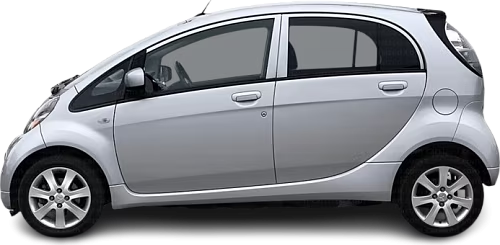Global EV Comparison: Mitsubishi i-MiEV Gen 1 vs Kia Niro EV Standard Range
Struggling to Decide? Let AI Help!
Your AI Summary Is Ready!
General Info
Since both vehicles have been discontinued, they are now only available on the used car market. You can get the Mitsubishi i-MiEV Gen 1 (2010-2021) for as low as €3990, while the Kia Niro EV Standard Range (2019-2022) begins at €17885.
The Mitsubishi i-MiEV Gen 1 (2010-2021) is a Hatchback, whereas the Kia Niro EV Standard Range (2019-2022) is a SUV.
| Property | Mitsubishi i-MiEV Gen 1 | Kia Niro EV Standard Range |
|---|---|---|
| Years of Production | 2010-2021 | 2019-2022 |
| Current Status | Discontinued | Discontinued |
| Country of Manufacture | Japan | South Korea |
| Body Style | Hatchback | SUV |
| Market Availability | EU, USA | EU |
| Price Europe (Used) | €3990 | €17885 |
| GCC Score | 4.2 | 5.2 |
Range and Efficiency
While the Kia Niro EV Standard Range (2019-2022) offers a longer real-world range and a bigger battery, it is less energy-efficient than the Mitsubishi i-MiEV Gen 1 (2010-2021).
| Property | Mitsubishi i-MiEV Gen 1 | Kia Niro EV Standard Range |
|---|---|---|
| Range (EPA) | 95 km | - Range (EPA) |
| Range (WLTP) | - Range (WLTP) | 289 km |
| Range (GCC) | 105 km | 246 km |
| Battery Capacity (Nominal) | 16 kWh | 42 kWh |
| Battery Capacity (Usable) | 14.5 kWh | 39.2 kWh |
| Efficiency per 100 km | 13.8 kWh/100 km | 15.9 kWh/100 km |
| Efficiency per kWh | 7.24 km/kWh | 6.28 km/kWh |
| Range and Efficiency Score | 5.7 | 5.8 |
Charging
Both vehicles utilize a standard 400-volt architecture.
The Mitsubishi i-MiEV Gen 1 (2010-2021) offers faster charging speeds at DC stations, reaching up to 50 kW, while the Kia Niro EV Standard Range (2019-2022) maxes out at 44 kW.
The Kia Niro EV Standard Range (2019-2022) features a more powerful on-board charger, supporting a maximum AC charging power of 7.2 kW, whereas the Mitsubishi i-MiEV Gen 1 (2010-2021) is limited to 3.7 kW.
| Property | Mitsubishi i-MiEV Gen 1 | Kia Niro EV Standard Range |
|---|---|---|
| Max Charging Power (AC) | 3.7 kW | 7.2 kW |
| Max Charging Power (DC) | 50 kW | 44 kW |
| Architecture | 400 V | 400 V |
| Charge Port | CHAdeMO | CCS Type 2 |
| Charging Score | 3 | 4 |
Performance
The Mitsubishi i-MiEV Gen 1 (2010-2021) is rear-wheel drive, while the Kia Niro EV Standard Range (2019-2022) offers a front-wheel drive system.
The Kia Niro EV Standard Range (2019-2022) boasts greater motor power and accelerates faster from 0 to 100 km/h.
| Property | Mitsubishi i-MiEV Gen 1 | Kia Niro EV Standard Range |
|---|---|---|
| Drive Type | RWD | FWD |
| Motor Type | PMSM | PMSM |
| Motor Power (kW) | 49 kW | 100 kW |
| Motor Power (hp) | 66 hp | 134 hp |
| Motor Torque | 196 Nm | 395 Nm |
| 0-100 km/h | 15.9 s | 9.8 s |
| Top Speed | 130 km/h | 155 km/h |
| Performance Score | 1.4 | 3 |
Dimensions
The Kia Niro EV Standard Range (2019-2022) is longer and wider, but the Mitsubishi i-MiEV Gen 1 (2010-2021) is taller.
The Kia Niro EV Standard Range (2019-2022) boasts a more extended wheelbase.
| Property | Mitsubishi i-MiEV Gen 1 | Kia Niro EV Standard Range |
|---|---|---|
| Length | 3475 mm | 4375 mm |
| Width (with Mirrors) | 1792 mm | - Width (with Mirrors) |
| Width (w/o Mirrors) | 1475 mm | 1805 mm |
| Height | 1610 mm | 1560 mm |
| Wheelbase | 2550 mm | 2700 mm |
Cargo and Towing
The Kia Niro EV Standard Range (2019-2022) provides more cargo capacity, featuring both a larger trunk and more space with the rear seats folded.
Neither car is equipped with a frunk (front trunk).
Neither vehicle is officially rated for towing in in the EU.
| Property | Mitsubishi i-MiEV Gen 1 | Kia Niro EV Standard Range |
|---|---|---|
| Number of Seats | 4 | 5 |
| Curb Weight | 1085 kg | 1646 kg |
| Cargo Volume (Trunk) | 235 l | 451 l |
| Cargo Volume (Max) | 860 l | 1405 l |
| Cargo Volume (Frunk) | - Cargo Volume (Frunk) | - Cargo Volume (Frunk) |
| Towing Capacity | - Towing Capacity | - Towing Capacity |
| Cargo and Towing Score | 4.2 | 5.5 |




